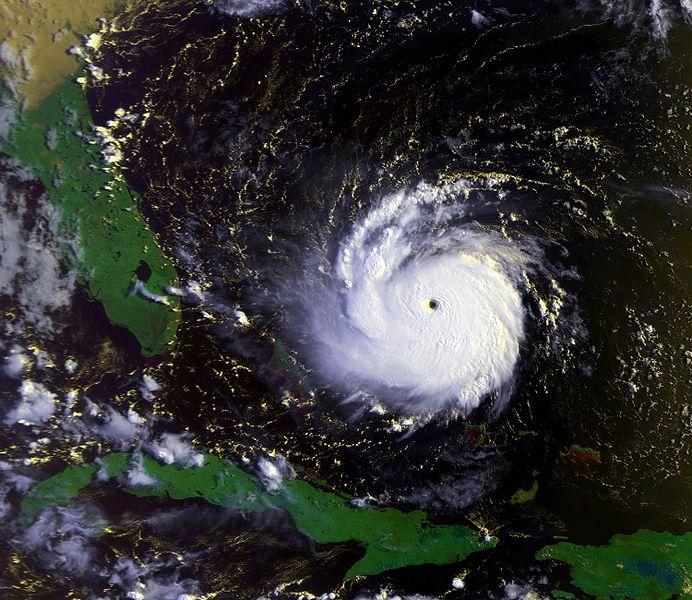The Atlantic ocean basin experienced a lull in tropical activity between 1991 and 1994. The 1992 season was no exception. In mid-August the first named storm of the year formed – Andrew. Andrew would go on to become one of the most vividly remembered hurricanes of the 20th century.
Andrew developed from a well-organized tropical wave that moved off the African coast on 14 August. On 16 August the National Hurricane Center (NHC) upgraded the system to a tropical depression. On 17 August, the depression became Tropical Storm Andrew and traveled west-northwest towards the Lesser Antilles. Steering currents caused the storm to track in a northwesterly direction over the next several days. It was at this time that the system encountered wind sheer that prevented the intensification of the storm. On 20 August, wind sheer was so significant that the storm drastically weakened and Andrew’s pressure rose to 1015 mb. However, the next day, wind sheer decreased, allowing Tropical Storm Andrew to intensify. On the morning of 22 August, the storm became a hurricane and continued to strengthen. Just 36 hours later, Hurricane Andrew had developed to its peak intensity as a Category 5 hurricane with winds of 282 km/h (175 mph) and a central pressure of 922 mb (hPa). As Hurricane Andrew passed over the Bahaman island of Eleuthera, 407 km (203 mi) east-southeast of Miami, FL, the island experienced 257 km/h (160 mph) winds and a 7 m (23 ft) storm surge. Andrew’s pressure rose to 941 mb as the hurricane weakened a bit over the Great Bahama Bank, however before making land fall the eye wall became better organized as the strom re-intensifed over the Straights of Florida. Hurricane Andrew made landfall along the southeastern tip of Florida (at the city of Homestead) on 24 August with sustained winds of 241 km/h (150 mph). It crossed southern Florida in just four hours at a rate of 29 km/h (18 mph), weakening to Category 3 status with winds of 201 km/h (125 mph) as it traversed the state. Hurricane Andrew then entered the Gulf of Mexico and continued to move quickly at a rate of about 26 km/h (16 mph) in a west-northwest direction while re-strengthening to Category 4 status with winds of 233 km/h (145 mph). As the steering currents over the Gulf of Mexico changed, the speed of the hurricane decreased drastically, and it began moving in a northwest direction towards Louisiana. On 26 August, Hurricane Andrew made a second landfall in a sparsely populated area in southeastern Louisiana about 37 km (23 mi) west-southwest of Morgan City, with sustained winds of 185 km/h (115 mph). The highest wind gust measured in Louisiana during the hurricane was 282 km/h (175 mph) in St. Mary Parish, an area off shore a few miles south of Morgan City. Gale force winds impacted some portions of the state for over 12 hours. Andrew quickly lost power and was downgraded to a tropical depression 12 hours after landfall in Louisiana. The system then merged with a frontal system over the Mid-Atlantic States by mid-day on 28 August, no longer exhibiting the qualities of a tropical cyclone. Damage resulting from Hurricane Andrew was very severe across south Florida, a majority of which was due to the hurricane’s exceptionally powerful winds at landfall. No conclusive maximum wind speeds could be determined in Florida, wind measurement tools were largely destroyed during the storm, but a few measurements obtained suggest that sustained winds were at least 225 km/h (140 mph) in some areas. Hurricane Andrew crossed Biscayne Bay, just south of Miami, as it made landfall and the area experienced a central storm surge of 5.2 m (16.9 ft). The fierce winds produced extensive environmental damage. In the Florida Everglades and 25% of the trees were toppled. Moderate damage was found on the coastal coral reefs of Florida, down to a level 23 m (75 ft) below the surface. Wind damage caused agricultural loss of $1.04 billion in Florida, predominantly affecting lime, avocado and specialty nursery crops. The community of Homestead, FL, where the storm made landfall in FL, was almost completely demolished by the hurricane, taking over 5 years to be rebuilt. The destruction of the town included the loss of the Homestead Air Force Base, which had originally been built to withstand 200 mph winds. About 63,000 homes in Dade County, FL were also destroyed, with another estimated 110,000 additional homes suffering significant damage. The large amount of devastation caused to homes can be correlated to poor construction, as other areas exposed to similar storm conditions with significantly less damage. 15 deaths were directly related to the hurricane in Florida. In Louisiana’s Atchafalaya River Basin, the largest swamp in the United States, 182 million fish were killed due to the storm’s disruption of their natural habitat, and 9.4 million other fish were killed off of the coast. The state saw significantly more rainfall than Florida as a result of the slower forward speed of the weakened storm, with a high measurement of 302.7 mm (11.9 in) at Hammond, LA. A 2.4-meter (8-foot) storm surge was recorded on the coast as the hurricane came ashore. The storm damaged corn, soy bean, and sugar crops, with an estimated $200 million in damage done to the sugar crop. Eight deaths were recorded, with two of the deaths caused by a hurricane-spawned F3 tornado In total, Hurricane Andrew killed 65 people and caused $26.5 billion (1992 USD) in damage, making it the second costliest hurricane in U.S. history only after Hurricane Katrina (2005). $25 billion (1992 USD) of the damage occurred in Dade Countly, FL alone, as this was the location that absorbed the initial impact of this powerful storm. Fast Facts:
|


